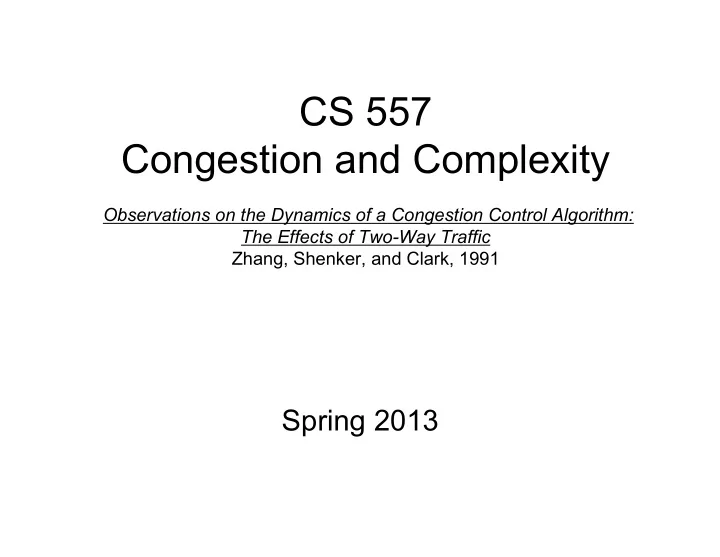

CS 557 Congestion and Complexity Observations on the Dynamics of a Congestion Control Algorithm: The Effects of Two-Way Traffic Zhang, Shenker, and Clark, 1991 Spring 2013
The Story So Far … . Some Essential Apps: DNS (naming) and NTP (time). Transport layer: End to End communication, Multiplexing, Reliability, Network layer: Addressing, Congestion control, Fragmentation, Dynamic Flow control, Routing, Best Effort Forwarding Data Layer: richly connected network (many paths) with many types of unreliable links
Main Points • Objective: – Analysis of Congestion Control Algorithms • TCP Tahoe congestion control in particular • Approach: – Simulations of a simple Network – Variations in traffic sources and windows • Contributions: – Clustering, ACK-Compression, Phase Sync. – How to properly conduct experiments
Congestion Control Algorithm • TCP algorithm from last lecture: • If (cwnd < sstresh) cwind += 1; else cwnd += 1/[cwnd] • If packet loss (duplicate acks or timeout) ssthresh=Max[cwnd/2, 2] cwnd =1 • Ignores maxwind (for flow control) – Not a factor in this study.
Network Topology Data size = 500 bytes Host 1 Host 2 Ack size = 50 bytes 10 Mbps Prop delay = 1 msec Switch Switch 1 2 50 Kbps Prop delay = .01 sec Prop delay = 1 sec Pipesize P = (Bandwidth*prop delay)/packetsize P = .125 packets (.01 sec delay) P = 12.5 packets (1 sec delay)
Utilization • Clearly can never get fully utilization on host-switch links. • Utilization on bottleneck link – Want bottleneck link always full • Pipe size – Link can hold 12.5 packets for 1 sec prop delay – Link can hold 0.125 packets for .01 sec prop delay – Larger pipe size decreases utliization • Need to feed more packets to keep the pipe full • Buffer size – Larger buffer size increases utilization • Always some packet in the queue ready to send
One-Way Traffic
One-Way Traffic Analysis (1/2) • Figure follows predictable TCP pattern – Window grows exponentially at first – Window grows linearly after passing threshold – Packet drop cuts the window back to 1 • Buffer Size and Throughput – Want full utilization of the bottleneck link – Increasing the pipe size decreases utilization – Increasing the buffer size increases the utilization • Primary Goal: – Queue size at bottleneck should never drop to 0 – Tune buffer size based on pipe size – “ Rule of Thumb ” for router buffer sizes • See “ Sizing Router Buffers ” , SIGCOMM 2004
One-Way Traffic Analysis (2/2) • Packets from a connection are clustered – All the packets from one connection linked together – Start as a cluster of 1 and always remain clustered – Results since each ack triggers data – Can be violated if random spacing after ack • Here each ack immediately triggers data – Can be violated due to retransmit • But each connection loses a packet in the congestion epoch. • Pacing or Non-Pacing – Pacing: data or acks not immediately transmitted – Non-pacing will exhibit clustering effect.
Summary for Part 1 • Observed One-Way Traffic and Found – Packet clustering – Increasing pipe size reduces utilization – Increasing buffer size increases utilization • Next Observed Two-Way Traffic and Found – Packet clustering – Increasing buffer size decreased utilization – Complex dynamics • Simplified Further to Fixed Window, Infinite Buffer – Fixed window results for stages 1,2,3,4,5 – Dynamic window results in Figures 4,5, 6, and 7 – Be prepared to explain these on an exam
Two-Way Traffic Rapid changes that don ’ t match changes in cwnd?? 5 packet change in less than packet trans time Buffer size = 30, util = 91% Buffer size = 60, util = 87% (??)
Discussion • Contradicts conventional wisdom: Larger buffer size results in smaller utliization • Too difficult to understand dynamics • Solution reduce to less complex model – One connection from host1 to host2 – One connection from host2 to host1
Two-Way Traffic Prop delay = 0.01 sec
Two-Way Traffic Prop delay = 1 sec
Discussion • Some predictions still hold – Packets are clustered – Two packets (= acceleration) dropped in congestion epoch • Some unexpected results – High frequency oscillations – Out of sync windows when r=0.01 – Drops are for the same connection when r=0.01 • Still too difficult to understand dynamics • Solution reduce to less complex model – Infinite buffer space at the switches – Fixed window size at the hosts
Two-Way Traffic Prop delay = 0.01 sec
Two-Way Traffic Prop delay = 1 sec
Ack-Compression • Ack messages encounter non-empty queues – Ack delay no longer simply a function of data packet arrivals • Acks become compressed together – Cluster together in the queue – Transmitted out in a cluster – Transmit time for acks in much smaller than data packets • Impact at the host – Burst of closely spaced ack packets – Send a burst of closely spaced data packets • Impact at the Queue – Burst of data packets arrive at queue and increase queue – Cluster of attacks leave queue and decrease queue size – Important to note queue is number of packets, • not number of bytes
Out of Phase Synchronization • Ack packets are never dropped – First ack never encounters full buffer. – Additional acks arrive at rate buffer drains • One Connection Loses Two Packets – First loss: cwind = 1, sthresh = cwind/2 – Second loss: cwind = 1 sthresh = cwind/2 = 1/2 – Slow start stops when window size = 2! • Low utilization while connection ramps up.
In Phase Synchronization • Ack packets are never dropped – First ack never encounters full buffer. – Additional acks arrive at rate buffer drains • Each Connection Loses One Packets – Both cwinds halved by congestion epoch – Reduced utilization on both directions. • In both sync cases, the effective pipesize varies due to the ack delays
Recommend
More recommend